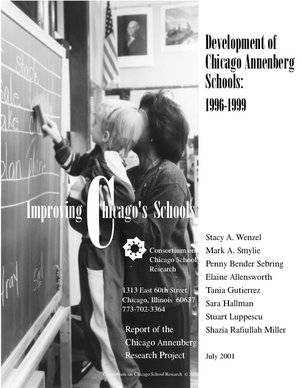1. In what ways did Annenberg schools develop between 1996 and 1999, the first three years of the Chicago Challenge?
2. What gains in student academic and non-academic outcomes have been achieved?
3. How did the schools that developed get better?
This is one of a series of technical reports charting the development of schools participating in the Chicago Annenberg Challenge. Using the Model of Essential Supports for Student Learning as its framework, the report looks at the small but potentially significant ways that Annenberg schools developed. Case studies and initial lessons on how to promote school development are presented.
Our longitudinal field research and analyses of Consortium survey data indicate that Annenberg schools developed in a number of small but potentially significant ways. They became stronger in several areas of school leadership and teacher professional community and some aspects of parent and community support and social trust. There is evidence that student-teacher personalism and teachers’ use of interactive teaching methods in reading also increased. Most of the development in Annenberg schools is reflected in general patterns of development citywide. In only a few areas did development in Annenberg schools exceed these general patterns. Likewise, we found that student achievement and social-psychological outcomes in Annenberg schools mirrored student outcomes across the system—students’ academic achievement as measured by the ITBS improved, but student engagement and classroom behavior levels declined.
The Challenge provides a valuable opportunity to better understand the process of school development. Through our field research, we have been able to closely examine schools’ efforts to develop. Our observations allow us to discern some initial lessons about how to promote school development. These include: 1) The need for coherent focus on multiple essential supports; 2) the growth of strong distributive leadership; 3) the development of a complementary array of external resources that are aligned with the school's development efforts; and 4) the use of multiple, complementary change strategies that are appropriate to the types of development sought and the contexts in which they are sought.
The findings presented here should be considered provisional. On the basis of evidence through 1999, we cannot draw any definitive conclusions about the overall contributions the Annenberg Challenge will make to school development and student learning in Chicago. We are not surprised by our findings through 1999. It takes a number of years to achieve whole school development and perhaps even longer for that development to translate into substantial, sustained gains in student outcomes. We will have much more to say about development of Chicago Annenberg schools, student outcomes, and how the school development is promoted in our final reports. These final reports will draw on data through 2001, the last year of the Challenge.



